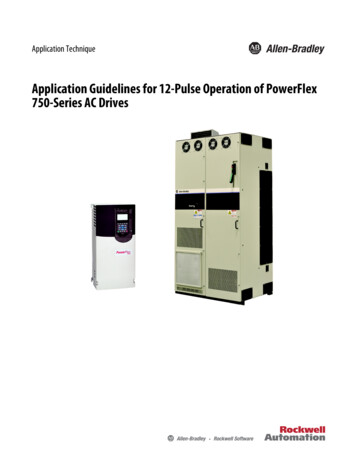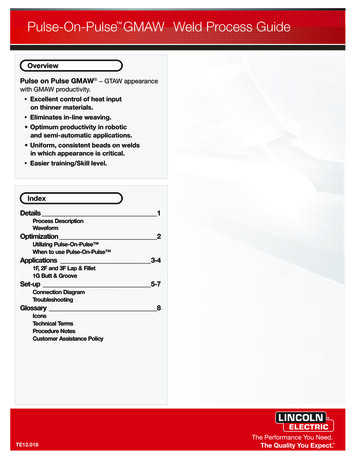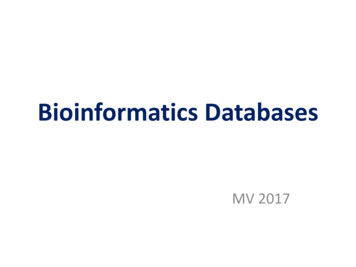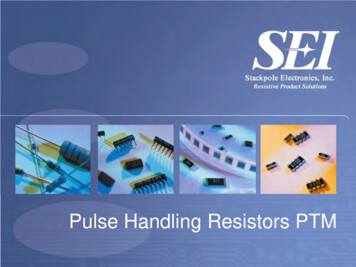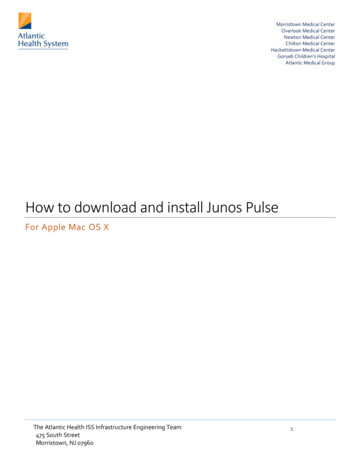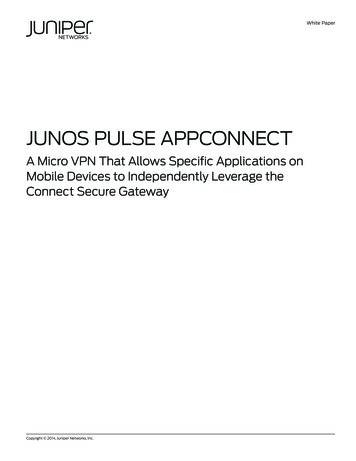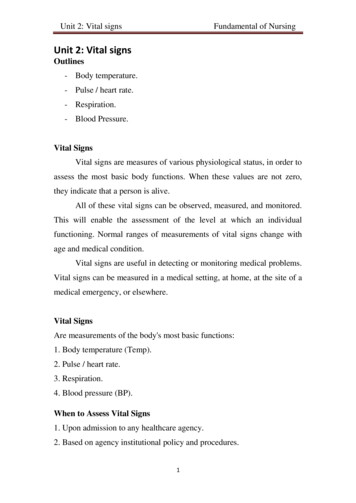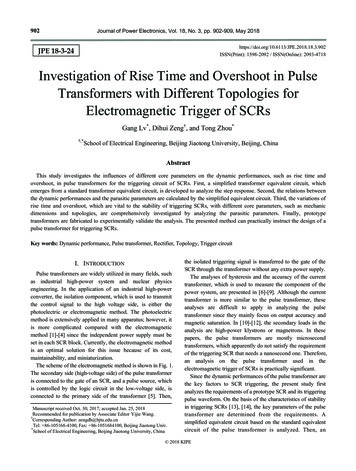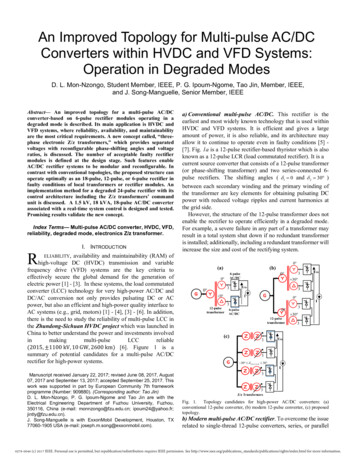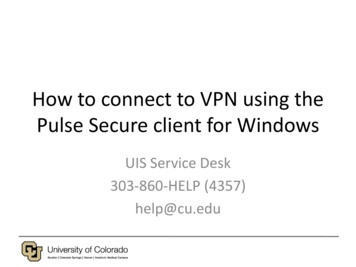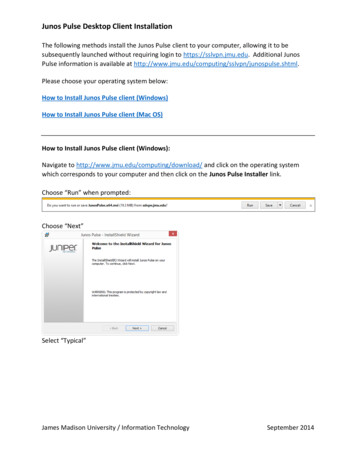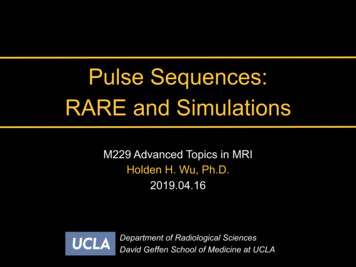
Transcription
Pulse Sequences:RARE and SimulationsM229 Advanced Topics in MRIHolden H. Wu, Ph.D.2019.04.16Department of Radiological SciencesDavid Geffen School of Medicine at UCLA
Class Business Final project-start thinkingcome to office hoursdiscussion in class next Tue 4/23presentation on 6/13 Thu Office hours Homework 1 due 4/26 Homework 2 due 5/3
Outline Rapid GRE-gradient and RF-spoiled GRE RARE (aka FSE, TSE) Pulse sequence simulations-MATLAB Bloch simulationsHomework 2
Why RARE (TSE)? Basic spin echo (SE) MRI is slow-TR on the order of 500 - 5000 msData acquisition of one k-space line per TR,readout duration of 10 ms or lessCould acquire more lines before completeT2 decay of Mxy
RARE (TSE) MRI Rapid Acquisition with RelaxationEnhancement (RARE)1,aka Fast Spin-Echo (FSE) or TurboSpin-Echo (TSE) Has virtually replaced SE for multipleclinical applications, esp. T2w imaging Challenging at high field ( 3 T)1HennigJ et al., MRM 1986
Spin Echo90o180oττT2 decayTE 2τTRSE
Spin Echo Image contrast-Based on TE, TRT1w, T2w, PDwCan augment with prep pulses-TSE Npe x TRTR 1000 ms, Npe 256: TSE 4 minusually combined with 2D multislice acq Scan time
Multi-echo Spin Echo90o180o180o180o.ττ2τ2τT2 decayTE1 2τTE2 4τTE3 6τ.TRSE1SE2SE3Can perform T2 mapping.
RARE (Turbo Spin Echo)90o180o180o180o.PETEeffky.kykxTRkykxkx
CPMG Conditionsconditions Carr-Purcell-Meiboom-Gillensure echoes only occur at desired-positions in the sequence, andsignals at each position have the samephase phase accrual btwn pulses ConstantSame area for crusher pairs90ox - τ - 180oy - 2τ - 180oy - 2τ - 180oy .-Phase encode rewinder
CPMG Conditions When satisfied-SE and STE coincide (same phase)secondary SE and FID are crushed Moving spins can violate CPMG
Spin Echo:zo90 x-o180 xzz90oxxyFP, T2xyzxyz180oxFP, T2xyxy
Spin Echo:zo90 x-o180 yzz90oxxyFP, T2xyzxyz180oyFP, T2xyxy
TSE Sequence Params90ox 180oy180oy180oy.ESP 2τTEeffEcho train length (ETL)Echo spacing (ESP)ETL.Number of shots (Nshot)Effective TE (TEeff)TRx Nshot
TSE Sequence Params ETL typically 4-16-Can’t be too high, due to T2 decay-Must accommodate RF, gradients, ADCShort ESP facilitates high ETL ESP typically 10 ms Example: readout until S 0.2 S-0S S0 * exp(-t/T2); assume T2 100 mst 160.9 msESP 8 ms; ETL 20ESP 4 ms; ETL 40
2D RARE SequenceBernstein et al., Handbook of MRI Pulse Sequences, Ch 16.4
2D RARE SequenceInterleaved 2D Multi-Slice AcquisitionBernstein et al., Handbook of MRI Pulse Sequences, Ch 16.4
3D RARE SequenceBernstein et al., Handbook of MRI Pulse Sequences, Ch 16.4
TSE Scan Time Scan time-Recall TSE Npe x TRSENshot Npe / ETLTTSE Nshot x TRTSE (TSE / ETL) x (TRTSE/TRSE)-Npe 256; ETL 16; Nshot 16TR 1000 ms: TTSE 16 sec-Npe 256*256; ETL 32; Nshot 2048TR 1000 ms: TTSE 34 min Example: 2D single slice Example: 3D volume
TSE Image Contrast TE-eff,TRT1w, T2w, PDwPE ordering affects TEeffBernstein et al., Handbook of MRI Pulse Sequences, Ch 16.4
TSE Image ContrastBernstein et al., Handbook of MRI Pulse Sequences, Ch 16.4
TSE Image Contrast Dual-echo PDw T2w in same TR Mag-prep modules (IR, SR, FS, etc.) Inherent flow suppression-only static spins see multiple 180s“dark/black blood” imaging
TSE Image ContrastDark Blood from Spin Echo1PettigrewRI et al., JMRI 1999
TSE Image ContrastDark Blood from Double Inversion-Recovery TSE1PettigrewRI et al., JMRI 1999
TSE Image Contrast Bright fat-J-coupling of protons in lipids (CH3-CH2-);fCS 25 Hz, fJ 7 Hz @ 1.5 TS S0 * exp(-t/T2) * cos(nech π fJ ESP)Shortening of apparent T2 (in SE)J-coupling negligible whenESP 1/[2 sqrt(fCS2 fJ2)] 20 ms @ 1.5 TIn TSE, short ESP avoids attenuation by Jcoupling, thus brighter fat signal
TSE Image ContrastSpin EchoTurbo Spin EchoBright Fat1HenkelmanR et al., JMRI 1992
TSE Image Contrast Magnetization transfer-MT effectmultiple refocusing pulses in TSEoff-resonance excitation in other slices;can lead to MT-induced signal loss
TSE Advantages Image contrast very similar to SE Robust to off-resonance effects (SE) Much faster scan than SE
TSE Challenges Blurring; edge enhancement; ghosting;-attention to PE ordering and ETLBernstein et al., Handbook of MRI Pulse Sequences, Ch 16.4
TSE ChallengesT2 blurring (PE) in single-shot TSEBernstein et al., Handbook of MRI Pulse Sequences, Ch 16.4
TSE Challenges RF power deposition increased-Specific Absorption Rate (SAR) W/kg;SAR θ2 (B0)2use reduced refocusing flip angles,e.g., θ 130o instead of 180o
Extensions and Variations Partial echo Multi-echo Mag-prep
Extensions and Variations Partial Fourier-Sample half of k-space data, reconstructassuming Hermitian symmetry (real-valuedMR images)reduce refocusing pulses, reduce SARbetter control of TEeff-Undersample k-space data, reconstructusing information from multiple coilsreduce refocusing pulses, reduce SAR Parallel imaging
Related Sequences TSE non-Cartesian trajectories-radial, rings, spiral, cylinders, etc. TSE-Dixon to separate bright fat Half-Fourier acquired single-shot turbospin echo (HASTE) Variable flip angle 3D TSE (SPACE,CUBE, etc.) to manage SAR, ETL
Related SequencesGradient And Spin Echo (GRASE)1,aka Turbo gradient spin echo (TGSE)1OshioK et al., MRM 1991Bernstein et al., Handbook of MRI Pulse Sequences, Ch 16.2
Clinical Applications The bread and butter sequence!-BrainBodyCardiacMusculoskeletaland more .
More About TSE FID, SE, secondary SE, StimulatedEchoes (STE) . Practical conditions-Reduced refocusing pulse anglesNon-uniform slice profilesB1 inhomogeneity
Summary RARE (Turbo Spin Echo)-efficient use of Mxyshares robustness of SEcore clinical sequencechallenges with SAR-generalized view of MR pulse sequences Multiple RF pulses - multiple echoes EPG next time!
Pulse SequenceSimulations
Outline Bloch Equation Simulations-basic operations (matrix form)MATLAB implementationexamples: rapid GREhomework
Bloch Simulation Bloch Equations-RF excitationT1, T2 decayfree precessiongradient pulse
Bloch SimulationRotation:21Rx ( ) 4 0020cos sin cos Rz ( ) 4 sin 0320cos sin 5 Ry ( ) 4 0cos sin sin cos 030103sin 50cos 00 51Nishimura, Principles of MRI, Ch. 2Hargreaves, MATLAB Bloch Simulator
Bloch SimulationFree precession:2cos !0 tRz (!0 t) 4 sin !0 t03sin !0 t 0cos !0 t 0 501Nishimura, Principles of MRI, Ch. 2
Bloch SimulationGeneral Rotation:z z’: arbitrary axis of rotationx'yR{', } ( ) Rz ( ')Ry ( )Rz ( )Ry ( )Rz (')Nishimura, Principles of MRI, Ch. 2
Bloch SimulationRelaxation Free Precession:M (t) 24et/T2000e00t/T20et/T13205 Rz ( !t)M (0) 40M0 (1 et/T1)35AM (0) BHargreaves, MATLAB Bloch Simulator
Bloch Simulation Transient state; steady state Different seq/tissue params Brian’s MATLAB Bloch sim tutorial-http://www-mrsrl.stanford.edu/ brian/bloch/
Bloch Simulation Example 1: Gradient Echo (long TR)-xrot.m, yrot.m, zrot.m, throt.mfreeprecess.mSim SatRecovery.madd gradient rewinders / spoilers, RF phasecycling to simulate rapid GRE sequences
Bloch Simulation Example 2: Balanced SSFP-xrot.m, yrot.m, zrot.m, throt.mfreeprecess.msssignal.mBalancedSSFP freqresp.mconsider different flip angle, T1, T2change TR and look at freq response
Bloch Simulation Homework 2, part 1A-Steady state for bSSFP, SSFP-FID andSSFP-Echo
Gradient-spoiled GRESS signal as a function of off-resonance:bSSFPGRE (SSFP-FID)T1 1000 ms, T2 100,200,500,1000 ms
Gradient-spoiled GRESS signal as a function of flip angle:bSSFPGRE (SSFP-FID)T1 1000 ms, T2 100,200,500,1000 ms
Gradient-spoiled GRE(reversed)SS signal as a function of flip angle:bSSFPGRE (SSFP-Echo)T1 1000 ms, T2 100,200,500,1000 ms
Bloch Simulation Homework 2, part 1B-Transition to steady state for bSSFPcatalyzation schemes
Balanced SSFPTransition to steady state:TR 5 msΔϕ πθ 60oT1 600 ms, T2 100 ms
Balanced SSFPTransition to steady state:TR 5 msΔϕ πθ 60oHzT1 600 ms, T2 100 ms
Balanced SSFPTransition to steady state (θ/2 -TR/2 prep):TR 5 msΔϕ πθ 60oT1 600 ms, T2 100 ms
Balanced SSFPTransition to steady state (θ/2 -TR/2 prep):TR 5 msΔϕ πθ 60oHzT1 600 ms, T2 100 ms
Balanced SSFP Linear ramp-up catalyzation-initial train of θ·[1:N]/N (same TR)Example:θ 60o, N 5ramp up pulses θlin [12o, 24o, 36o, 48o, 60o]
Homework 2 Pulse Sequence Simulations-1. Bloch: Steady state comparison, bSSFPtransient state and catalyzation2. EPG: SSFP-FID, RF-spoiled GRE-PDF and MATLAB code Due 5 pm, 5/3 Fri by email
Thanks! Web resources-ISMRM 2010 Edu: Miller, WeigelISMRM 2011 Edu: Miller, Weigel-Bernstein et al., Handbook of MRI SequencesHaacke et al., Magnetic Resonance ImagingScheffler, Concepts in MR 1999; 11:291-304Hennig, JMR 1988; 78:397-407 Further reading
Thanks! Acknowledgments-Brian Hargreaves-EPG and MATLAB demo Next lectureHolden H. Wu, wulab
Pulse Sequences: RARE and Simulations M229 Advanced Topics in MRI Holden H. Wu, Ph.D. 2019.04.16 Department of Radi
